The Mushroom Club
TMC / 2017
About Reconstructing History
About Reconstructing History
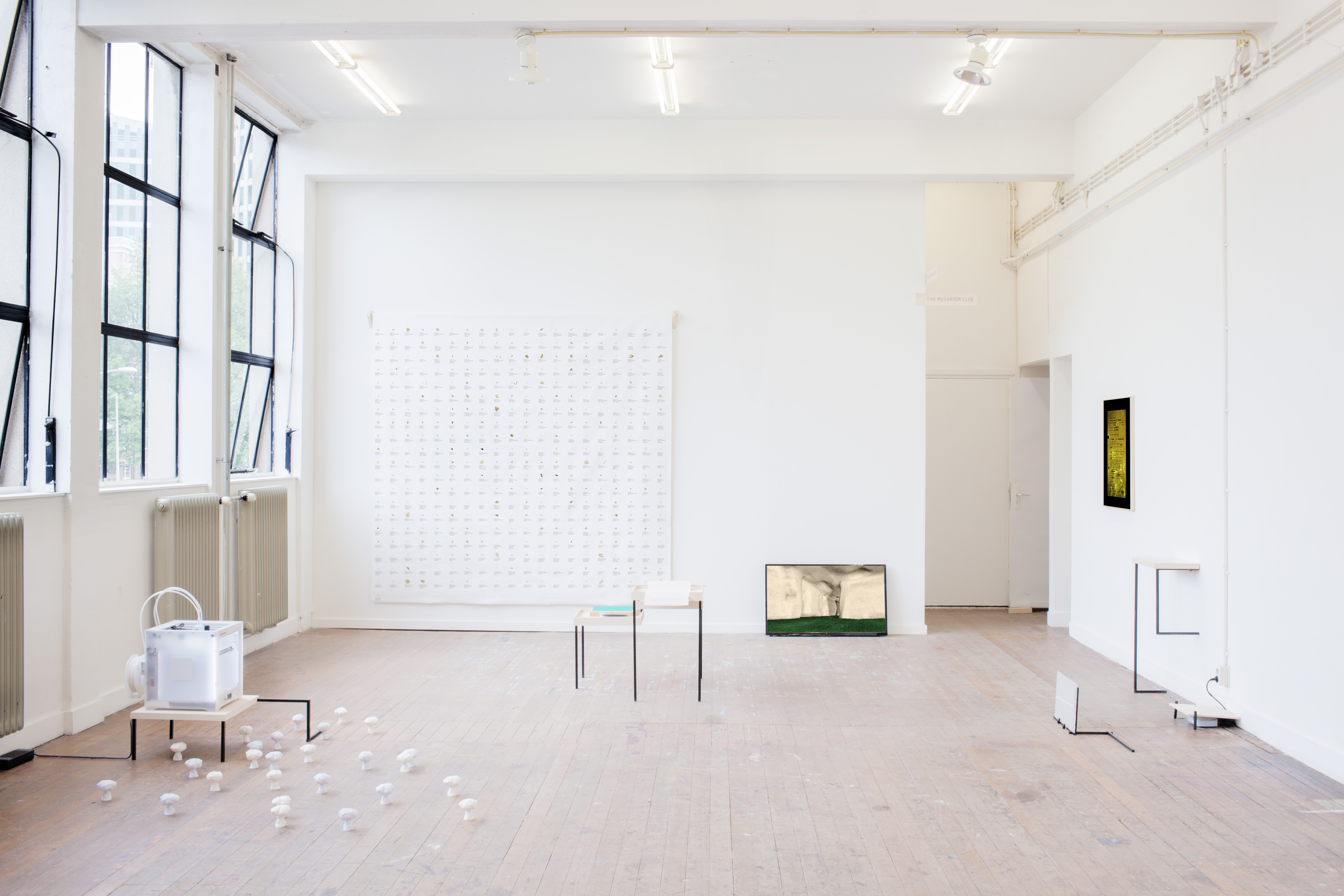 ⇢ Royal Academy of Art, The Hague (KABK), 2017
⇢ Royal Academy of Art, The Hague (KABK), 2017TMC / 2017
From The Mushroom Club
For years, it was the best kept secret in the Netherlands: The Mushroom Club, a former NATO headquarters inside a mountain on the Dutch-Belgian border during the Cold War. This underground network of tunnels was stripped in 1992 and officially erased on paper. What is left is an empty quarry, objects taken out of their original context and the often inconsistent recollections of former employees.
Since this headquarters is erased both on paper and physically, I had to depend on other forms of reconstructing an image of the place. Using different kinds of hard and soft evidence, from fingerprints on paper to memories of former employers, I reconstructed the headquarters enabling others to visit the place.
The final installation comprises seven elements that are based on this fragmented information. All elements together serve as fictive fragments – building blocks – that allow the viewer to reconstruct a mental image of the headquarters. The Mushroom Club is a document that embraces the inaccuracies of writing history. It departs from the idea that history is a piece of fiction, composed of facts. Reflecting on the representation of historical events in our collective consciousness and questioning the rol of the documenter in unpicking and reweaving of fragmented information to a linear story.
![]()
![]()
![]()
![]()
#02 / 2017
About Latent Fingerprints
A collection consisting of 6 documents found in a small archive in the Dutch village Ulenstraten kept by a former employee. The documents have been treated with the chemical 1,2-indanedione to reveal the hidden fingerprints. Many different types of paper – although looking clean – can carry a thin film of dirt and sweat particles that show the personal contact that people had with the object.
![]()
![]()
⇢ Royal Academy of Art, The Hague (KABK), 2017
#03 / 2017
About Collection of Quotes
A collection of swipes was taken in all 401 confined areas of the subterranean complex, to see if some information could be retrieved from the smallest particles in the headquarters. On the map, these microscopic particles are arranged by street name and street number. The rooms that could not be entered due to potential danger of collapse are marked with an X.
![]()
⇢ Royal Academy of Art, The Hague (KABK), 2017
#04 / 2017
About Collection of Quotes
A slideshow of 137 conflicting recollections from 14 former employees. They are put together in such a way that every quote connects to the next. Together they seem to form a cohesive narrative.
![]()
#04 / 2017
About Golf Course Reconstruction
Reconstruction of the golf course inside the complex based on information from archive material, as well as a wide variety of recollections from by former employees.
![]()
![]()
![]()
#05 / 2017
About Mushroom Farm
Prior to being the Cold War headquarters, the tunnels housed a mushroom growing facility. The images are taken in an abandoned mushroom farm found inside the cave. The mouldy mushrooms were extremely fragile and could not be touched or taken out of the cave to be photographed in daylight.
![]()
![]()
![]()
![]() ↪ Galerie Heden, The Hague, 2017
↪ Galerie Heden, The Hague, 2017
![]()
#001 / 2017
About Melting Marl
According to the former employees, maps have been found that prove that the cave was a nuclear target during the Wold War. On the table are results of an attempt to heat marl to the temperature of an atomic explosion. The cave consists mainly of marl, a soft, white, porous rock. Pieces of marl taken from the cave have been heated up to 3100° Celsius. Temperatures of a nuclear explosion, however, reach those in the interior of the sun, about 100,000,000° Celsius.
⇢ Read More
06 / 2017
About The Mushroom Club
From June 2017 BJP, issue #7860 – Ones to Watch - Lisa van Casand, The Talent Issue
For The Mushroom Club, Lisa van Casand focused on a Cold War-era former Nato HQ on the Dutch-Belgian border, from which all official documentation had been destroyed.
For Lisa van Casand, photography provides carte blanche to investigate places and people she would otherwise not have access. Her projects often revolve around waarheidsvinding, a peculiarly Dutch term best – if imprecisely – translated as ‘truth-finding’, an interest she attributes to her upbringing.
“I grew up with people around me that had quite a variety of strong beliefs,” says the 26-year-old from Eindhoven. “Which is not necessarily a bad thing in itself but it did confuse me at a young age – how people could believe so strongly in opposite things?”
Though interested in the idea of photography as evidence and document, it was the fallacy of the tools we use to order reality, and the limitations of seeing, that she often reflects on in her research-led projects. “I am drawn to things that are shrouded in mystery. The bigger the impossibility of reaching the object of investigation, the better,”says the final-year student at the Royal Academy of Art in The Hague.
Clarity and knowledge are not the desired outcomes of her research: it’s the ambiguity of the journey that counts. The subjective act of producing and interpreting information is a red thread through all of her work, which often takes enigmatic historical events or scientific ideas as its starting point.
For The Mushroom Club, van Casand focused her attention on a Cold War-era former Nato headquarters inside a hill on the Dutch-Belgian border. All official documentation and evidence of the underground network of tunnels had been destroyed, so she set herself the task of patching together an impression of the base by interpreting the fragments of information available.
Van Casand chose not to photograph the site as it exists now, conscious that the end point would be to merely linger on what is no longer there. Instead she treated the material she gathered as “building blocks” for an imagined contemporary document that found its form across several different elements. From a 3D-reconstruction of the mountain’s golf course, to a book bringing together conflicting accounts from former employees into a seemingly cohesive narrative, her rendering of the former Nato HQ embraces the inaccuracies of documentation and the subjective vision underlying these processes.
In leaving the information inconclusive, van Casand relies on the viewer to piece together some of the puzzle. “I am searching for ways to give the viewer a more active role in viewing the work, by ensuring that the work is not complete without them,” she explains. “In this way, the final image is the mental image in the mind of the viewer.”
For her next project she plans to push the role of the viewer even further, exploring our individual responses to colour by seeing if it’s possible to create a work “that everyone will see differently”.
Since this headquarters is erased both on paper and physically, I had to depend on other forms of reconstructing an image of the place. Using different kinds of hard and soft evidence, from fingerprints on paper to memories of former employers, I reconstructed the headquarters enabling others to visit the place.
The final installation comprises seven elements that are based on this fragmented information. All elements together serve as fictive fragments – building blocks – that allow the viewer to reconstruct a mental image of the headquarters. The Mushroom Club is a document that embraces the inaccuracies of writing history. It departs from the idea that history is a piece of fiction, composed of facts. Reflecting on the representation of historical events in our collective consciousness and questioning the rol of the documenter in unpicking and reweaving of fragmented information to a linear story.
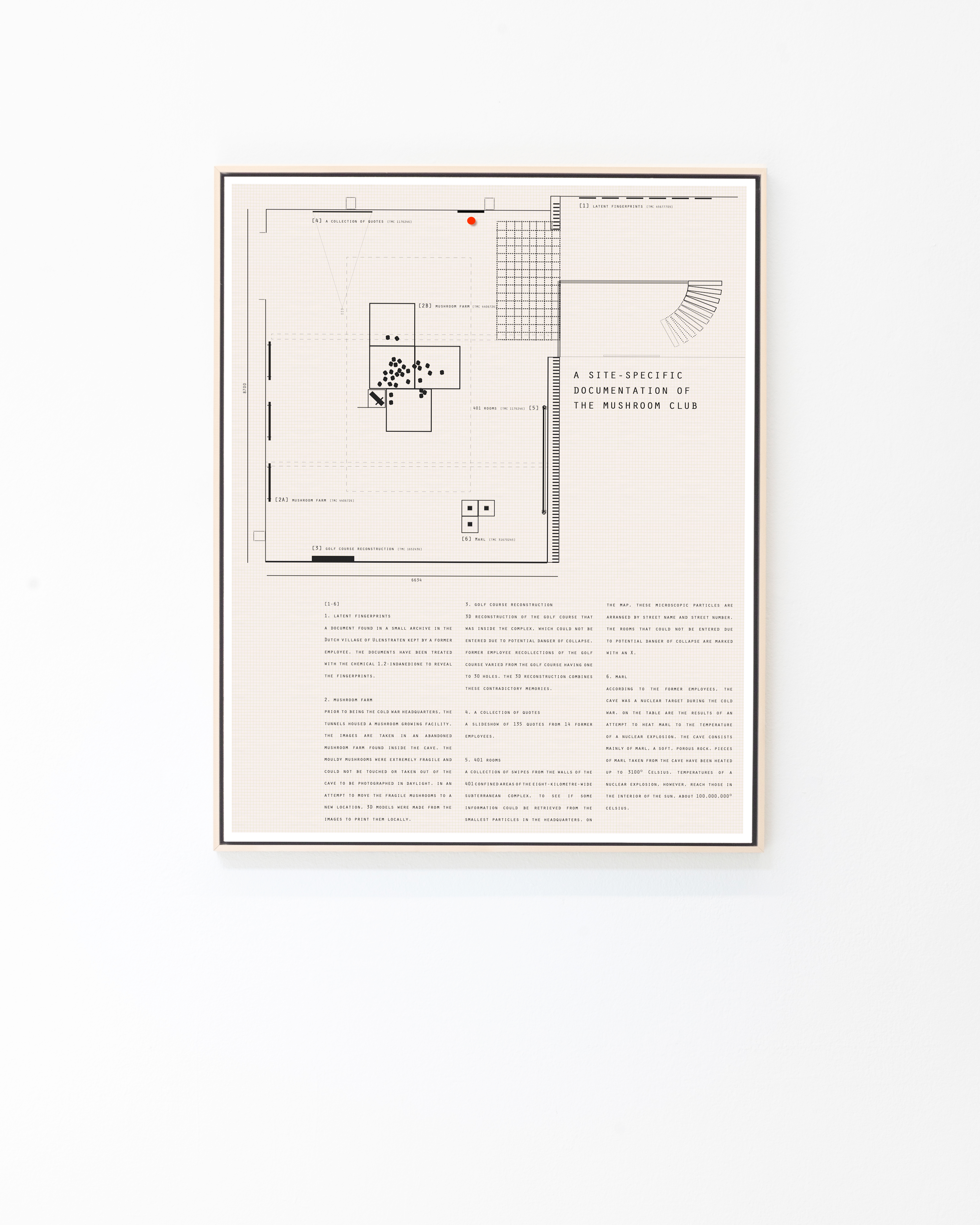
⇢ Galerie Heden, The Hague, 2018
#01 / 2017
About Site specific documentation of The Mushroom Club
A floorplan with a small description of the elements in the space.
#01 / 2017
About Site specific documentation of The Mushroom Club
A floorplan with a small description of the elements in the space.



#02 / 2017
About Latent Fingerprints
A collection consisting of 6 documents found in a small archive in the Dutch village Ulenstraten kept by a former employee. The documents have been treated with the chemical 1,2-indanedione to reveal the hidden fingerprints. Many different types of paper – although looking clean – can carry a thin film of dirt and sweat particles that show the personal contact that people had with the object.


⇢ Royal Academy of Art, The Hague (KABK), 2017
#03 / 2017
About Collection of Quotes
A collection of swipes was taken in all 401 confined areas of the subterranean complex, to see if some information could be retrieved from the smallest particles in the headquarters. On the map, these microscopic particles are arranged by street name and street number. The rooms that could not be entered due to potential danger of collapse are marked with an X.
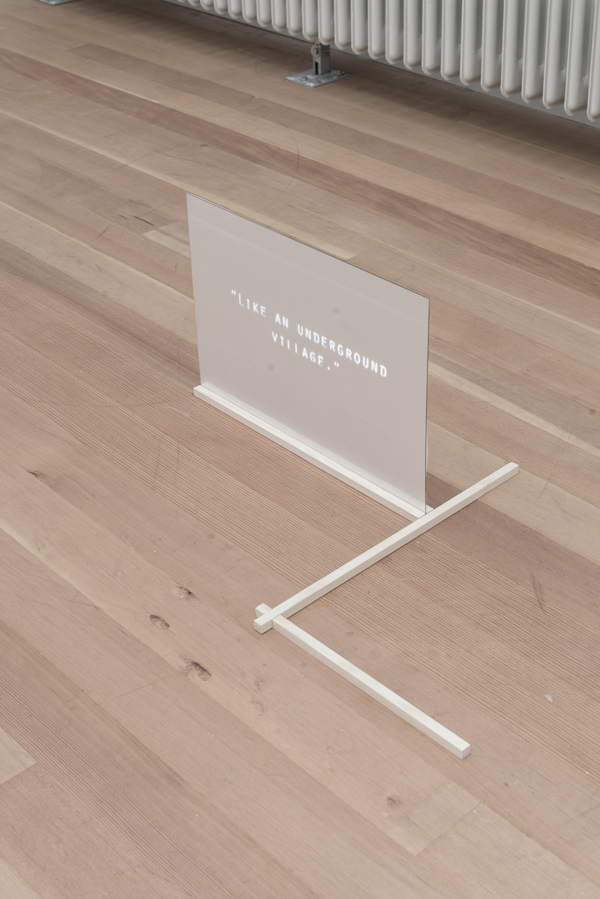
⇢ Royal Academy of Art, The Hague (KABK), 2017
#04 / 2017
About Collection of Quotes
A slideshow of 137 conflicting recollections from 14 former employees. They are put together in such a way that every quote connects to the next. Together they seem to form a cohesive narrative.
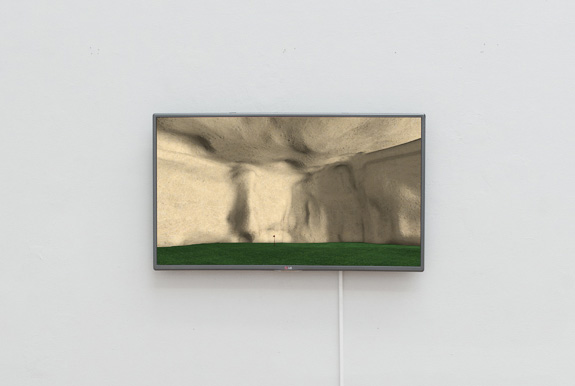
#04 / 2017
About Golf Course Reconstruction
Reconstruction of the golf course inside the complex based on information from archive material, as well as a wide variety of recollections from by former employees.



#05 / 2017
About Mushroom Farm
Prior to being the Cold War headquarters, the tunnels housed a mushroom growing facility. The images are taken in an abandoned mushroom farm found inside the cave. The mouldy mushrooms were extremely fragile and could not be touched or taken out of the cave to be photographed in daylight.



#06 / 2017
About 3D Mushroom
In an attempt to move the fragile mushrooms to a new location, 3D models were made from the images to print them locally. The mushrooms are printed continuously during the exhibition.
About 3D Mushroom
In an attempt to move the fragile mushrooms to a new location, 3D models were made from the images to print them locally. The mushrooms are printed continuously during the exhibition.
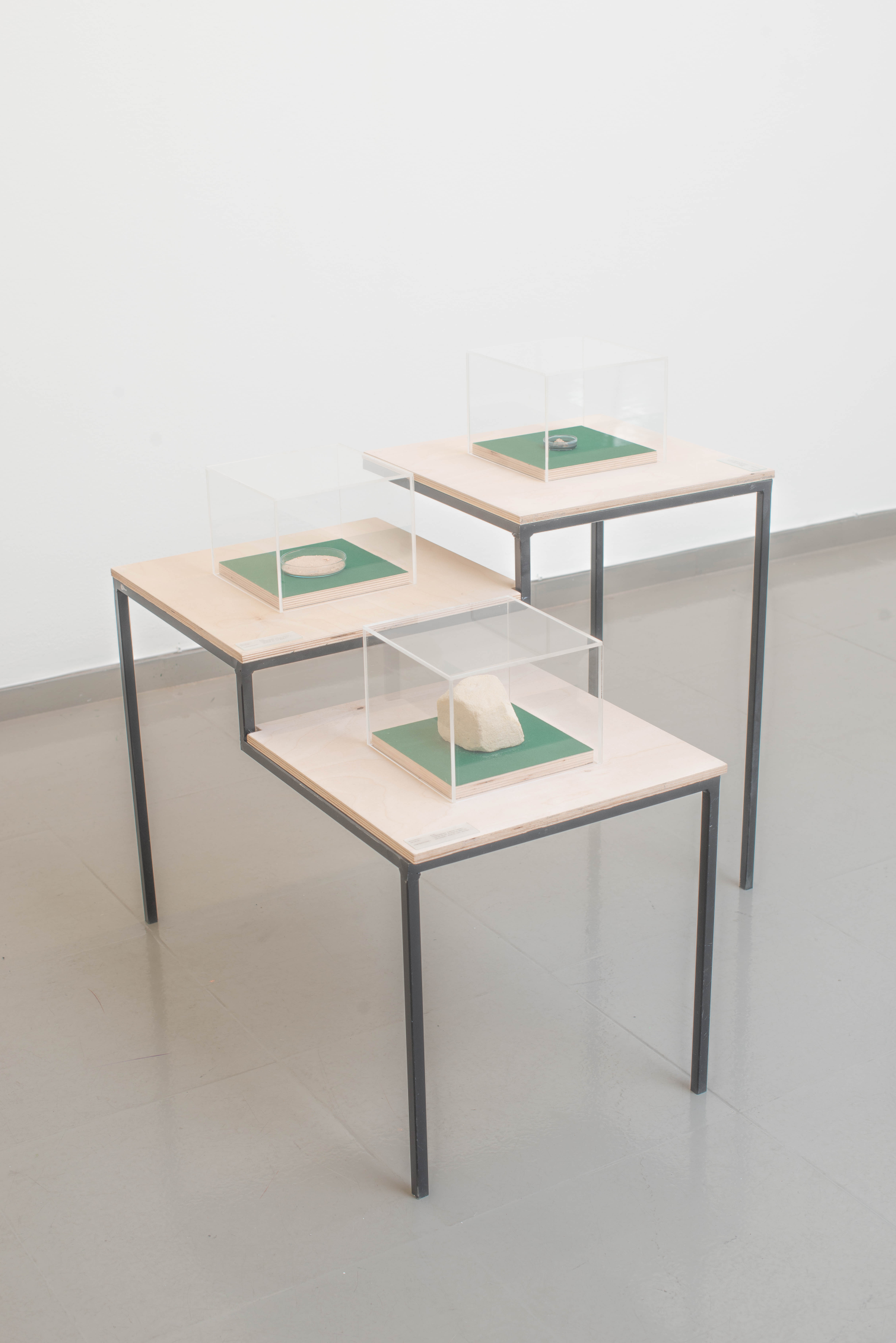 ↪ Galerie Heden, The Hague, 2017
↪ Galerie Heden, The Hague, 2017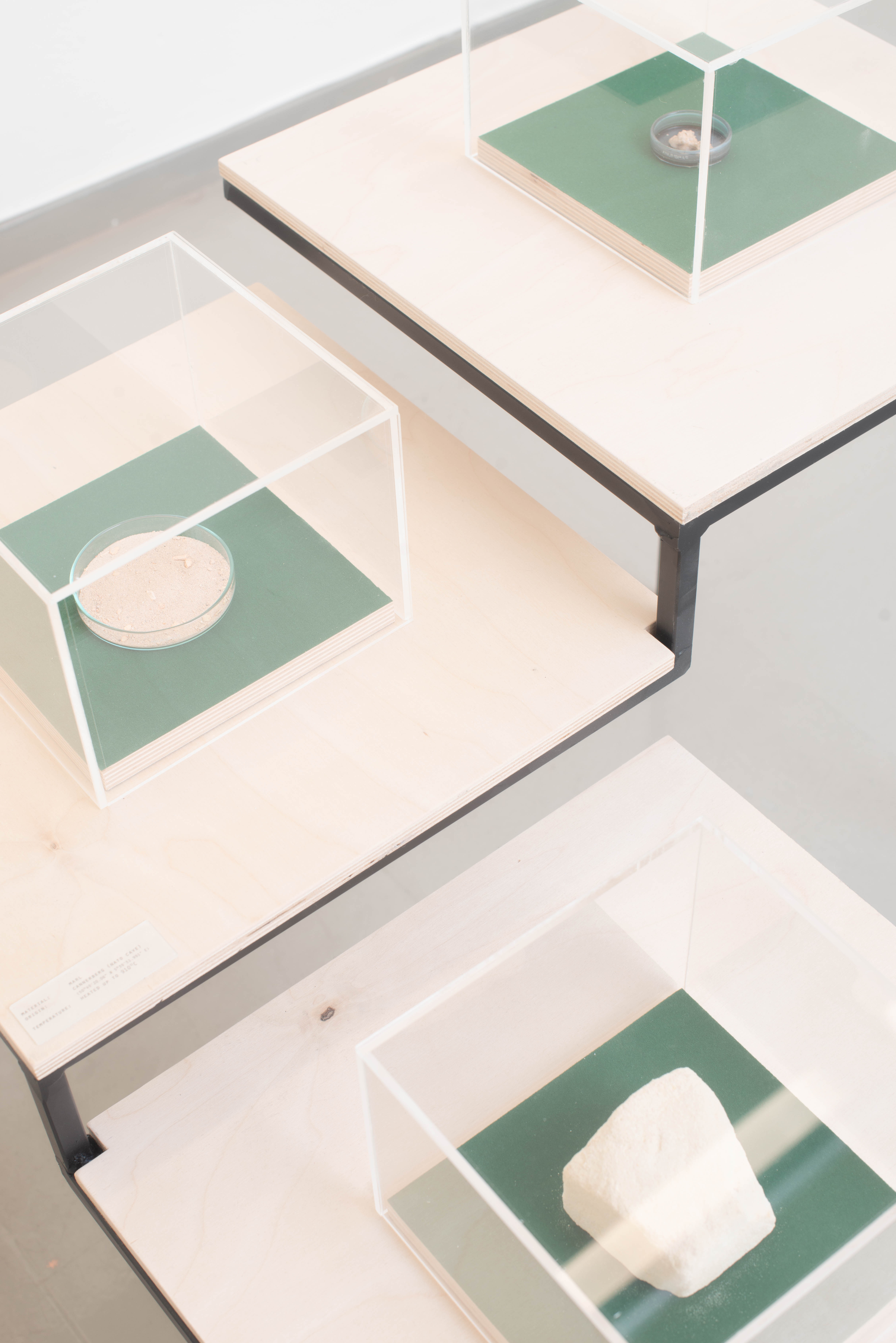
#001 / 2017
About Melting Marl
According to the former employees, maps have been found that prove that the cave was a nuclear target during the Wold War. On the table are results of an attempt to heat marl to the temperature of an atomic explosion. The cave consists mainly of marl, a soft, white, porous rock. Pieces of marl taken from the cave have been heated up to 3100° Celsius. Temperatures of a nuclear explosion, however, reach those in the interior of the sun, about 100,000,000° Celsius.
⇢ Read More
Written by Sophie Wright For British Journal of Photography
06 / 2017
About The Mushroom Club
From June 2017 BJP, issue #7860 – Ones to Watch - Lisa van Casand, The Talent Issue
For The Mushroom Club, Lisa van Casand focused on a Cold War-era former Nato HQ on the Dutch-Belgian border, from which all official documentation had been destroyed.
For Lisa van Casand, photography provides carte blanche to investigate places and people she would otherwise not have access. Her projects often revolve around waarheidsvinding, a peculiarly Dutch term best – if imprecisely – translated as ‘truth-finding’, an interest she attributes to her upbringing.
“I grew up with people around me that had quite a variety of strong beliefs,” says the 26-year-old from Eindhoven. “Which is not necessarily a bad thing in itself but it did confuse me at a young age – how people could believe so strongly in opposite things?”
Though interested in the idea of photography as evidence and document, it was the fallacy of the tools we use to order reality, and the limitations of seeing, that she often reflects on in her research-led projects. “I am drawn to things that are shrouded in mystery. The bigger the impossibility of reaching the object of investigation, the better,”says the final-year student at the Royal Academy of Art in The Hague.
Clarity and knowledge are not the desired outcomes of her research: it’s the ambiguity of the journey that counts. The subjective act of producing and interpreting information is a red thread through all of her work, which often takes enigmatic historical events or scientific ideas as its starting point.
For The Mushroom Club, van Casand focused her attention on a Cold War-era former Nato headquarters inside a hill on the Dutch-Belgian border. All official documentation and evidence of the underground network of tunnels had been destroyed, so she set herself the task of patching together an impression of the base by interpreting the fragments of information available.
Van Casand chose not to photograph the site as it exists now, conscious that the end point would be to merely linger on what is no longer there. Instead she treated the material she gathered as “building blocks” for an imagined contemporary document that found its form across several different elements. From a 3D-reconstruction of the mountain’s golf course, to a book bringing together conflicting accounts from former employees into a seemingly cohesive narrative, her rendering of the former Nato HQ embraces the inaccuracies of documentation and the subjective vision underlying these processes.
In leaving the information inconclusive, van Casand relies on the viewer to piece together some of the puzzle. “I am searching for ways to give the viewer a more active role in viewing the work, by ensuring that the work is not complete without them,” she explains. “In this way, the final image is the mental image in the mind of the viewer.”
For her next project she plans to push the role of the viewer even further, exploring our individual responses to colour by seeing if it’s possible to create a work “that everyone will see differently”.
